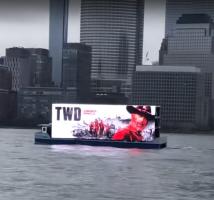 Roughly a year ago, a tug pulling a barge carrying a double-sided 60 foot long LED screen blasting animated, high-definition digital ads for everything from beer to movies, appeared on the Hudson and East Rivers, threatening to turn the riverscape into another neon Times Square. The company which operated the barge, Ballyhoo Media, proclaimed their barge “the future of digital billboard advertising.” Many New Yorkers considered it to be a nuisance and an eyesore.
Roughly a year ago, a tug pulling a barge carrying a double-sided 60 foot long LED screen blasting animated, high-definition digital ads for everything from beer to movies, appeared on the Hudson and East Rivers, threatening to turn the riverscape into another neon Times Square. The company which operated the barge, Ballyhoo Media, proclaimed their barge “the future of digital billboard advertising.” Many New Yorkers considered it to be a nuisance and an eyesore.
Since then there have been lawsuits and legislation to restrict the barge and the others like it. At the same time, the Ballyhoo CEO Adam Shapiro promised to fight back and indeed flout the actions taken against the floating advertizements.
For all the sturm und drang, the battle appears now to be over and the billboard barge has lost. Gothamist reports:
On Tuesday, the city declared victory in its fight over the Miami-based company, announcing a settlement in the lawsuit filed this past March. Under the terms of the agreement, Ballyhoo is prohibited from displaying water-based ads anywhere in the state of New York.
To ensure compliance—and because the company has a habit of proudly flouting the law—Ballyhoo will be forced to “temporarily relocate the Vessel to Florida,” according to the agreement put in place by Judge Louis Stanton. CEO Adam Shapiro has also consented to a $100,000 entry of judgment, which will be awarded to the city in the event that he violates the settlement. In exchange, the city has agreed to drop its suit against the boats, which carried a potential fine in excess of $3 million.
…Still, in a statement sent to Gothamist on Tuesday, Shapiro again asserted that his company had never violated the law, but was merely electing to leave New York on its own terms.
“Ballyhoo Media complied with all local, state and federal laws during our time in New York and still has the legal right to safely operate in New York waters,” he said. “But we have decided to stop fighting with the City and State and instead focus on pursuing opportunities elsewhere.”
Those opportunities could potentially still include parts of the Hudson River, according to the CEO, who notes, “We retain the right to return to any waterway outside New York, including New Jersey.”

Good thing it was specified to be moved to Florida. The operators might have moved it as far as NJ then operated in NJ waters in sight of NY.